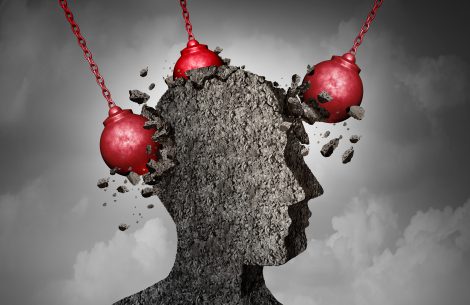There are headaches, and there are headaches. Everyone has them. Sometimes, they are just slightly annoying. Sometimes, they are absolutely terrible and paralyzing. While many people have headaches, there is often an underlying cause, and in Traditional Chinese Medicine, the reason may be surprising:
The pain doesn’t always start with the head.
At least 45 million people in the U.S. have headaches, including recurrent and migraines, according to the National Headache Foundation. Traditional Chinese medicine regards the head has closely connected with other parts of the body, and those connections may contribute to headaches, which cannot always be relieved by pain medication.
That’s why it’s important to underlying patterns of disharmony in the body, to find ways to treat headaches.
The causes and symptoms of headaches have been many tributaries, if you will. As a result, there can be different triggers and their frequency and severity depends on each person. Some headaches happen repeatedly, while others happen only occasionally. In Traditional Chinese Medicine, each individual is diagnosed for that particular person and the kind of headache he or she is experiencing. In TCM, a headache includes the “root,” which may cause the headache, and the “branch,” which is the actual headache. Many Chinese herbs have been identified as treating headaches, as well as acupuncture and Chinese massage.
Types of Headaches
Migraine headaches are characterized by painful, disabling and recurring symptoms. They have no known cause, treatment or cure. Many people have moderate or severe headaches. Migraines can be pulsating and throbbing. Sometimes migraines it occurs with nausea, vomiting, and has an impact of sensitivity to light or noise. Migraine headaches may have effect as many as 5 million Americans.
Tension headaches are a common type of headache, often with a dull pain at the temples, back of the head or neck. There also could be a heavy feeling. There are some possible reasons for a tension headache. The neck may be slightly out of alignment, which may be the result of poor sleeping.
Cluster headaches are described as a severe debilitating pain on the side of the head and sometimes come with watery eyes and nose. Cluster headaches are also considered one of the most painful types of headaches, and can last over several weeks, and rare. They strike quickly without warning, but are rare and not life-threatening. They often disappear pretty quickly.
Rebound headaches are usually caused by reactions to over-the-counter painkillers. are If you’re using drugs to treat headaches (couple of times a week), you’re at an increased risk of such headaches because then you’re building some kind of dependency. Rebound headaches usually stop when you stop taking the pain medication.
Sinus headaches are common for people who suffer from sinus infections. Sinuses are the spaces inside your forehead behind the bridge of the nose. When they get inflamed because of allergic reaction or infection, the sinuses bring on the headaches, which may also include a fever.
Post-traumatic headaches are often linked to diseases or neurovascular conditions.
Nearly 1.7 million traumatic brain injuries occur every year in the U.S., and headaches are among the most common complaints, which can occur after injuries, from the mild to the severe. It is associated with many symptoms including dizziness, insomnia, poor concentration and others.
Treating Headaches
So what can we do to address headaches? Some Chinese herbs that have been identified as helping treat headaches.
Ginkgo biloba is described as being one of the longest living tree species in the world and helps treat inflammation, including headaches. Most supplements use the concentrated ginkgo biloba extract that comes from the dried green leaves of the tree. The active ingredients include flavonoids, which can help improve circulation by relaxing blood vessels and decreasing the stickiness of platelets.
Xiao Yao Wan, also known as the Free and Easy Wanderer, has been used for migraines during women’s menstruation cycles, and for regulating hormonal imbalances in women.
Po Chai pills are a supplement made from a blend of herbs, also used for colds and chills.
Cnidium 9 promotes blood circulation and relieves stagnation of blood, and also used in a combination formula that utilizes a variety of blood vitalizing herbs that have been used to thrwart headaches.
Ge Gen is a pungent herb that relieves fevers and headaches.
Acupuncture
One of the most effective Chinese remedies for headaches is acupuncture; one study found that this natural treatment reduced pain by 31 percent with chronic tension headaches, according to the American Migraine Foundation. Based on a recent systematic review of 22 clinical trials involving nearly 5,000 people, there is evidence that acupuncture reduces the frequency of migraines by 50 percent comparable to medications, the foundation said.
Chinese Massage. That is a type of massage that can work for a minor headache, using your thumb, for example, to point directly between the eyebrows at the forehead.
What You Eat and Drink
There are some small things you can do to help alleviate headaches.
- Try giving up coffee (or caffeine) or alcohol for a while, maybe a month or two.
- Drink lots of water – maybe eight glasses, because it’s important to stay hydrated to ward off headaches.
- This is tough: maybe stay away from chocolate or even sugar, for a bit of time.
References:
- Chinese Herbal Therapy for Chronic Tension-Type Headache. Tong, YQ, Yu Li et al.
- Evidence-Based Complementary and Alternative Medicine . Medicine Vol. 2015. Article ID 208492. 4 pages.

